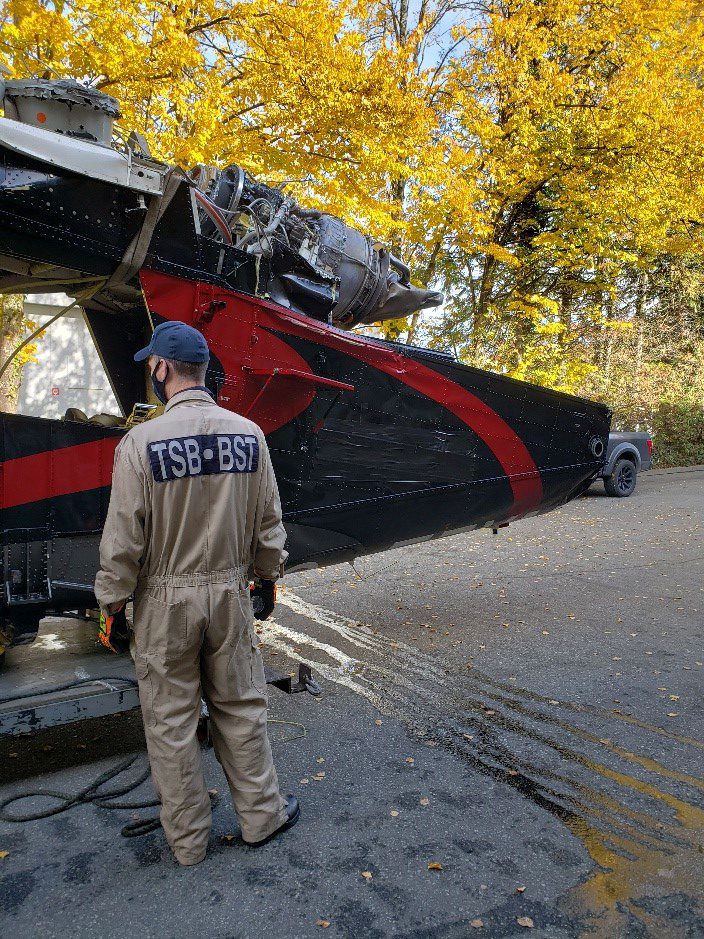Collision with water
Black Tusk Helicopter Inc.
Kaman Aerospace Corporation K-1200 (helicopter), C-FZVM
Killam Bay, British Columbia
The occurrence
The helicopter was located using sonar 8 days after the occurrence. The pilot was fatally injured. The investigation was unable to locate and recover the entire helicopter. However, based on the debris and damage to the helicopter, the investigation determined that the helicopter experienced an in-flight breakup of the twin rotor system before impacting the water.
The TSB laboratory conducted various tests on the recovered portions of the main rotor blades and found that the departure of the servo flap afterbody on main rotor blade 0517B created an out-of-track condition that caused a cyclic imbalance and a sudden vibration of the left main rotor system, the flutter of the 3 other rotor blades, and the failure of the left-pylon structure. This led to the collision between a blade on the left rotor and a blade on the right rotor that resulted in the in-flight breakup of the rotor system. The investigation also found that the fracture of the bond joint between the inboard closeout and the servo flap afterbody on main rotor blade 0517B likely initiated a fatigue crack in the servo flap skin, between the D-spar and the afterbody, that progressed until the servo flap afterbody separated in flight. If the quality of the bond joint between the inboard closeout and the servo flap afterbody of Kaman K-1200 main rotor blades is inconsistent, the structural integrity of the servo flap can be compromised, leading to a risk that the servo flap will be unable to withstand normal aerodynamic loads.
While the helicopter was equipped with a 406 MHz ELT, the ELT was submerged following the helicopter’s impact with water, and no signal was received by search and rescue agencies. In this occurrence, given that the pilot was in regular radio communication with the company, the local crew was able to locate the occurrence site quickly and start searching the area. Automatically deployable ELTs may be installed in aircraft operating over water. They will detach from the aircraft and remain on the water’s surface to transmit both GPS (global positioning system) coordinates and the 121.5/406 MHz signal. Consequently, aircraft operating over water are at risk of a delayed search and rescue response if they are not equipped with an automatically deployable ELT.
The occurrence helicopter was not equipped with a flight data recorder or a cockpit voice recorder, nor was either required by regulation. Although the availability of other sources of data provided significant information for this investigation, the helicopter’s exact manoeuvring during the final moments and the time elapsed between the final data point and the actual impact with the surface could not be determined.
Following a fatal accident with no survivors or witnesses, an investigation may never be able to determine the exact causes and contributing factors unless the aircraft is equipped with an on-board recording device. This occurrence demonstrates that if cockpit and flight data recordings are not available to an investigation, there is a risk that safety deficiencies will not be identified to advance transportation safety.
Following this occurrence, Kaman Aerospace Corporation (Kaman) performed tests to verify the airworthiness of the servo flap; however, Kaman plans to further evaluate the flap’s fatigue capability.
In addition, the Kaman Model K-1200 K-MAX Maintenance and Servicing Instructions were revised on 01 June 2023. The latest revision provides added instructions for the repair of chordwise paint cracks in the bond line of the servo flap inboard closeout. The instructions note that the flap must be removed from service if the crack extends beyond the paint layer.
On 19 July 2023, the TSB issued an Air Transportation Safety Advisory Letter to Transport Canada (TC) to inform TC that, in at least 2 fatal Kaman K-1200 accidents, a main rotor servo flap experienced fatigue fractures before there was a catastrophic failure and the afterbody of the flap separated from its spar. The letter also indicated that the timeline for the progression of the flap fractures to a catastrophic failure was unknown, and that the contribution of flight loading from the phase of flight and pilot input needed further examination. TC indicated that it would monitor the industry for any additional servo flap cracking and, pending the corrective action(s) from the FAA, may take interim action if warranted.
Investigation information
Download high-resolution photos from the TSB Flickr page.
Class of investigation
This is a class 2 investigation. These investigations are complex and involve several safety issues requiring in-depth analysis. Class 2 investigations, which frequently result in recommendations, are generally completed within 600 days. For more information, see the Policy on Occurrence Classification.
TSB investigation process
There are 3 phases to a TSB investigation
- Field phase: a team of investigators examines the occurrence site and wreckage, interviews witnesses and collects pertinent information.
- Examination and analysis phase: the TSB reviews pertinent records, tests components of the wreckage in the lab, determines the sequence of events and identifies safety deficiencies. When safety deficiencies are suspected or confirmed, the TSB advises the appropriate authority without waiting until publication of the final report.
- Report phase: a confidential draft report is approved by the Board and sent to persons and corporations who are directly concerned by the report. They then have the opportunity to dispute or correct information they believe to be incorrect. The Board considers all representations before approving the final report, which is subsequently released to the public.
For more information, see our Investigation process page.
The TSB is an independent agency that investigates air, marine, pipeline, and rail transportation occurrences. Its sole aim is the advancement of transportation safety. It is not the function of the Board to assign fault or determine civil or criminal liability.
